Process-Driven Applications with BPMN
Business & Finance, Industries & Professions, Information Management, Nonfiction, Computers, Advanced Computing, Information Technology, General Computing| Author: | Volker Stiehl | ISBN: | 9783319072180 |
| Publisher: | Springer International Publishing | Publication: | September 17, 2014 |
| Imprint: | Springer | Language: | English |
| Author: | Volker Stiehl |
| ISBN: | 9783319072180 |
| Publisher: | Springer International Publishing |
| Publication: | September 17, 2014 |
| Imprint: | Springer |
| Language: | English |
How can we optimize differentiating business processes and exploit their full potential? Here Volker Stiehl provides answers, utilizing the various options that the BPMN (Business Process Model and Notation) standard offers for planning, implementing and monitoring processes.
The book presents an approach for implementing an architecture for applications that strives to find a balance between development and maintenance costs, sustainability, scalability and fault tolerance; that meets flexibility requirements without becoming inordinately complex itself; and that keeps the end application as abstract as possible from the system landscape in which it operates. Based on the semantic enhancements found in version 2.0 of the BPMN standard, which have made it possible to execute process models, his approach exploits BPMN to create and run complete application architectures. In this context, BPMN is not just used to model the business processes of the application, as the “B” in BPMN might suggest; but also to model and execute the integration processes between the systems. Throughout the book, the software package SAP Process Orchestration is used to illustrate the implementation of the proposed architecture, yet all recommendations are intentionally kept generic so that they can be implemented on any other comparable platform as well.
Software architects, IT managers, software developers and project managers, as well as students of information and business technology will find the book a valuable resource. The proposed application architecture offers them a detailed blueprint, the principles of which they can use to plan and implement process-driven distributed applications.
How can we optimize differentiating business processes and exploit their full potential? Here Volker Stiehl provides answers, utilizing the various options that the BPMN (Business Process Model and Notation) standard offers for planning, implementing and monitoring processes.
The book presents an approach for implementing an architecture for applications that strives to find a balance between development and maintenance costs, sustainability, scalability and fault tolerance; that meets flexibility requirements without becoming inordinately complex itself; and that keeps the end application as abstract as possible from the system landscape in which it operates. Based on the semantic enhancements found in version 2.0 of the BPMN standard, which have made it possible to execute process models, his approach exploits BPMN to create and run complete application architectures. In this context, BPMN is not just used to model the business processes of the application, as the “B” in BPMN might suggest; but also to model and execute the integration processes between the systems. Throughout the book, the software package SAP Process Orchestration is used to illustrate the implementation of the proposed architecture, yet all recommendations are intentionally kept generic so that they can be implemented on any other comparable platform as well.
Software architects, IT managers, software developers and project managers, as well as students of information and business technology will find the book a valuable resource. The proposed application architecture offers them a detailed blueprint, the principles of which they can use to plan and implement process-driven distributed applications.















